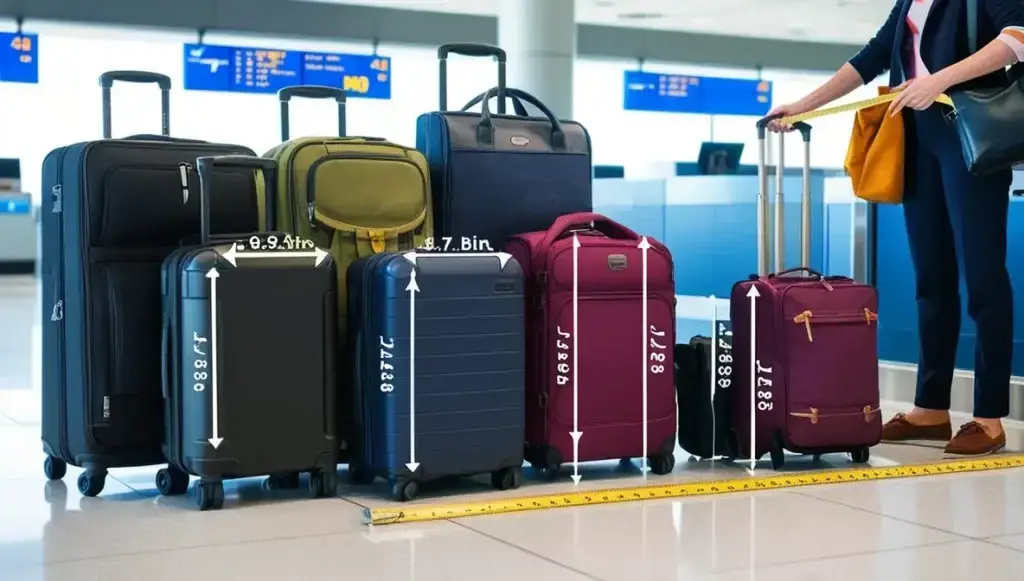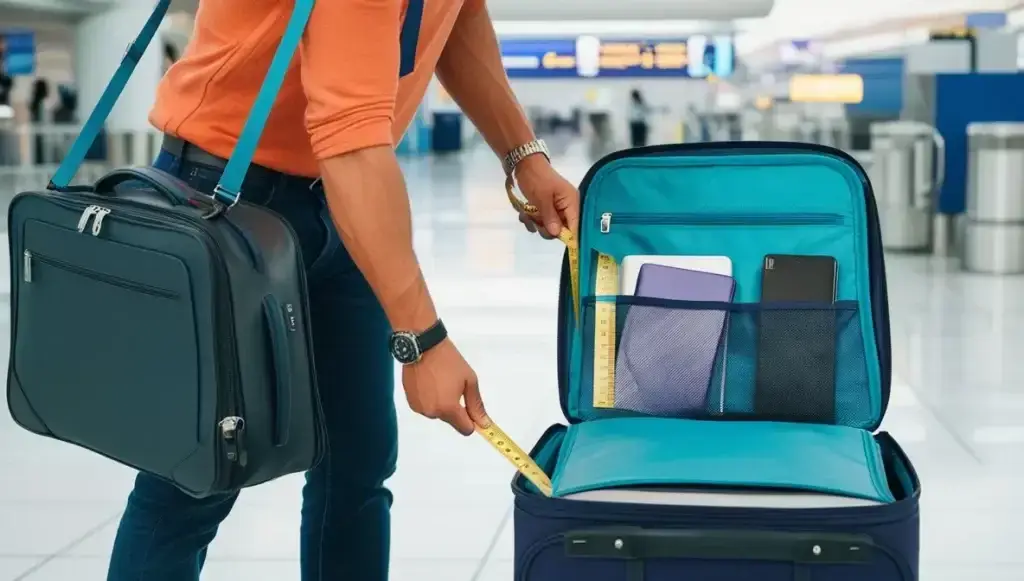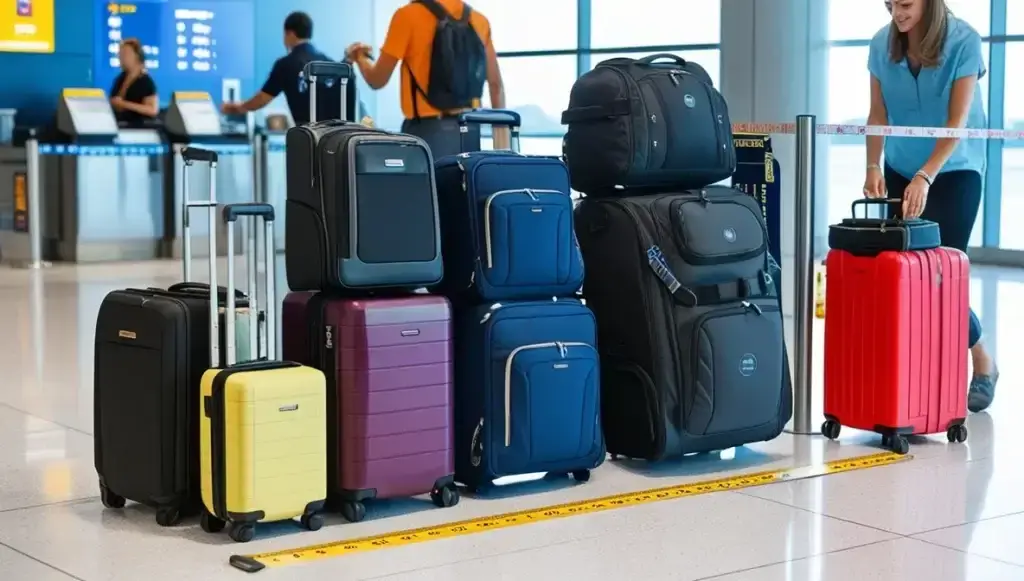When you’re gearing up for air travel, one thing you can’t overlook is the size of your carry on luggage. It might seem like a small detail, but it can make or break your travel experience. Every airline has its own set of rules, and these can change whether you’re flying across the country or halfway around the world. Understanding these regulations isn’t just about avoiding extra fees and last-minute stress—it’s about making your journey as smooth as possible. In this article, we’ll break down everything you need to know about carry-on luggage sizes, complete with easy-to-read charts and tips to help you navigate the maze of airline policies like a pro.
Why Carry On Luggage Size Matters
Picture this: You’re at the airport, excited for your trip, when you suddenly find yourself at the gate, frantically trying to stuff your bag into the luggage sizer. The agent gives you that all-too-familiar look—sorry, but your bag is too big. Now, you’re either paying a fee you didn’t budget for or, even worse, checking your carefully packed carry-on.
Avoiding this scenario is why understanding carry-on size restrictions is so important. Airlines have tightened their policies, and being prepared helps you dodge those last-minute surprises. Whether you’re a jet-setting pro or gearing up for that big vacation, knowing the rules means you can pack smart and start your journey stress-free.
Domestic Carry On Luggage Size
Below is a chart detailing the carry-on luggage dimensions for major U.S. airlines:
| Airline | Carry On (Inches) | Carry On (Centimeter) | Weight |
|---|---|---|---|
| Alaska Airlines | 22 x 14 x 9 | 56 x 36 x 23 | __ |
| American Airlines | 22 x 14 x 9 | 56 x 36 x 23 | __ |
| Delta Air Lines | 22 x 14 x 9 | 56 x 36 x 23 | __ |
| EasyJet | 22 x 18 x 10 | 56 x 45 x 25 | 33 lbs (15 kg) |
| Frontier Airlines | 24 x 16 x 10 | 60 x 39 x 24 | 35 lbs (16 kg) |
| Hawaiian Airlines | 22 x 14 x 9 | 56 x 36 x 23 | 25 lbs (11 kg) |
| Jet Blue | 22 x 14 x 9 | 55.88 x 35.56 x 22.86 | __ |
| Southwest Airlines | 24 x 16 x 10 | 60 x 40 x 25 | __ |
| Spirit Airlines | 22 x 18 x10 | 56 x 46 x 25 | __ |
| United Airlines | 22 x 14 x 9 | 56 x 35 x 23 | __ |
Major U.S. Airlines’ Carry On Size Policies
When it comes to carry-on size, most U.S. airlines are pretty consistent, typically allowing bags up to 22 x 14 x 9 inches. But if you’re flying with Southwest, you’ve got a bit more wiggle room—they let you bring a bag that’s up to 24 x 16 x 10 inches. A little extra space never hurt, right? Just remember, those measurements usually include everything, from the wheels to the handles. And while many domestic airlines don’t fuss over the weight of your carry-on, it’s always smart to double-check your airline’s specific rules before you pack. After all, better safe than sorry!
Tips for Selecting the Right Carry-On for Domestic Flights
- Opt for a Standard Size: You know that moment when you see someone struggling to shove an oversized bag into the overhead bin? Let’s avoid being that person. A bag within the standard 22 x 14 x 9-inch range will fit most U.S. airlines, making your boarding process a breeze.
- Consider Expandable Options: Expandable bags can be lifesavers when you’re bringing back souvenirs (or doing some last-minute packing). Just make sure that when expanded, your bag still fits within those airline limits—no one wants to deal with a surprise gate check.
- Check for Airline-Specific Luggage: Did you know some luggage brands design bags specifically for certain airlines? It’s true! These bags take the guesswork out of packing, giving you one less thing to worry about on travel day.
International Carry-On Luggage Size
Here’s a chart showing the carry-on luggage dimensions for several international airlines:
| Airline | Carry On (Inches) | Carry On (Centimeter) | Weight |
|---|---|---|---|
| Aegean Airlines | 22 x 18 x 10 | 56 x 45 x 25 | 17.5 lbs (8 kg) |
| Aer Lingus | 21.5 x 15.5 x 9.5 | 55 x 40 x 24 | 22 lbs (10 kg) |
| Aerolineas Argentinas | 22 x 14 x 10 | 55 x 35 x 25 | 11 lbs (5 kg) |
| Aeromexico | 21.5 x 15.7 x 10 | 55 x 40 x 25 | 22 lbs (10 kg) |
| Air Asia | 22 x 14 x 9 | 56 x 23 x 36 | 15 lbs (7 kg) |
| Air Astana | 22 x 18 x 10 | 56 x 45 x 25 | 17.6 lbs (8 kg) |
| Air Baltic | 21 x 15 x 9 | 55 x 40 x 23 | 17.6 lbs (8 kg) |
| Air Canada | 21.5 x 15.5 x 9 | 55 x 40 x 23 | no weight limit applies must be light enough to be store it in the overhead bin |
| Air Caraibes | 21 x 13 x 9 | 55 x 35 x 25 | 26.5 lbs (12 kg) |
| Air China | 22 x 16 x 8 | 55 x 40 x 20 | 11 lbs (5 kg) |
| Air Europa | 21.7 x 13.8 x 9.8 | 55 x 35 x 25 | 22 lbs (10 kg) |
| Air France | 21 x 13 x 9 | 55 x 35 x 25 | 26.4 lbs (12 kg) |
| Air New Zelaand | 17.7 x 22 x 10 | 45 x 56 x 25 | 15 lbs (7 kg) |
| Alaska Airlines | 22 x 14 x 9 | 56 x 36 x 23 | __ |
| Allegiant Air | 22 x 16 x 10 | 55 x 40 x 25 | __ |
| All Nippon Airways (ANA) | 22 x 16 x 10 | 55 x 40 x 25 | 22 lbs (10 kg) |
| American Airlines | 22 x 14 x 9 | 56 x 36 x 23 | __ |
| British Airways | 22 x 18 x 10 | 56 x 45 x 25 | 51 lbs (23 kg) |
| Cathay Pacific | 22 x 14 x 9 | 56 x 36 x 23 | 15 lbs (7 kg) |
| Delta Air Lines | 22 x 14 x 9 | 56 x 36 x 23 | __ |
| EL AL | 22 x 18 x 10 | 56 x 45 x 25 | 26.4 lbs (12 kg) |
| Emirates | 22 x 14 x 9 | 56 x 36 x 23 | 15 lbs (7 kg) |
| Etihad Airways | 22 x 14 x 9 | 56 x 36 x 23 | 15 lbs (7 kg) |
| Frontier Airlines | 24 x 16 x 10 | 60 x 39 x 24 | 35 lbs (16 kg) |
| Hawaiian Airlines | 22 x 14 x 9 | 56 x 36 x 23 | 25 lbs (11 kg) |
| Japan Airlines | 22 x 18 x 10 | 56 x 45 x 25 | 17.5 lb (8 kg) |
| Jet Blue | 22 x 14 x 9 | 55.88 x 35.56 x 22.86 | __ |
| KLM Royal Dutch Airline | 21.5 x 13.5 x 10 | 55 x 35 x 25 | 26.4 lbs (12 kg) |
| Korean Air | 21.4 x 15.5 x 7.5 not to exceed 45 ins | 55 x 40 x 20 not exceed 115 cm | 22 lbs (10 kg) |
| Iberia Airlines | 22 x 15.7 x 9.8 | 56 x 40 x 25 | 22 lbs / 10 kg |
| Lufthansa | 22 x 16 x 9 | 55 x 40 x 23 | 17 lbs (7 kg) |
| Norwegian Airlines | 22 x 16 x 9 in | 55 x 40 x 23 | 22 lbs (10 kg) |
| Philippine Airlines | 22 x 14 x 9 | 56 x 36 x 23 | 15 lbs (7 kg) |
| Quantas | 22 x 14 x 9 not exceed 45in | 55 x 35 x 23 not exceed 115 | 22 lbs (10 kg) |
| Qatar | 22 x 14 x 9 in | 56 x 36 x 23 | 15 lbs (7 kg) |
| RyanAir | 22 x 16 x 8 | 55 x 40 x 20 | 22 lbs (10 kg) |
| Scandinavian Airlines (SAS) | 22 x 16 x 9 | 55 x 40 x 23 | 17.5 lb (8 kg) |
| Singapore Airlines | 45 total inches | 115 total linear | 15 lbs (7 kg) |
| Spirit Airlines | 22 x 18 x10 | 56 x 46 x 25 | __ |
| Southwest Airlines | 24 x 16 x 10 | 60 x 40 x 25 | __ |
| Sun Country Airlines | 24 x 16 x 11 | 60 x 40 x 27.5 | 35 lbs (16 kg) |
| Thai Airways | 22 x 18 x 10 | 56 x 45 x 25 | 15 lbs (7 kg) |
| Turkish Airlines | 22 x 12 x 9 | 55 x 30 x 23 | 17 lbs (8 kg) |
| United Airlines | 22 x 14 x 9 | 56 x 35 x 23 | __ |
| Virgin Atlantic | 22 x 14 x 9 | 56 x 36 x 23 | 22 lbs (10 kg) |
Differences Between Domestic and International Carry-On Sizes
Let’s face it, flying internationally is a different ball game. While U.S. airlines are generally lenient, with standard carry-on sizes, international flights can feel like a maze of different rules.
- Size Variability: Traveling across the pond? Your go-to carry-on might be a bit too big. For example, while domestic flights usually allow 22 x 14 x 9 inches, international airlines often prefer something slightly smaller, like 21.5 x 15.5 x 9 inches.
- Weight Restrictions: Here’s where it gets tricky—international flights love their weight limits. While your bag might squeeze into the sizer, it also needs to be light enough to lift into the overhead bin without breaking a sweat.
- Regional Differences: Think Europe or Asia. Even within the same region, different airlines have different rules. Planning ahead can save you from playing luggage roulette at the check-in counter

Factors Affecting Carry-On Size Limits
Several factors influence airlines’ carry-on size limits:
- Aircraft Type
- Larger planes (e.g., wide-body jets for long-haul flights) typically have more spacious overhead bins, allowing for slightly larger carry-ons.
- Regional jets and smaller narrow-body aircraft have more limited overhead space, necessitating stricter size limits.
- Airline Business Model
- Low-cost carriers often have more restrictive carry-on policies to encourage passengers to pay for checked bags.
- Full-service airlines may allow slightly larger or heavier carry-ons, especially for premium cabin passengers.
- Route and Flight Duration
- Long-haul international flights generally have more lenient carry-on allowances compared to short domestic hops.
- Airlines may adjust limits based on typical passenger needs for specific routes.
- Cabin Class
- First and business class passengers are often allowed larger or additional carry-on items.
- Economy passengers usually face the strictest size and weight restrictions.
- Operational Considerations
- Airlines aim to ensure sufficient overhead bin space for all passengers.
- Stricter limits help speed up boarding and reduce delays caused by bag issues.
- Regulatory Requirements
- Some countries have specific regulations regarding carry-on sizes that airlines must adhere to when operating there.
- Some countries have specific regulations regarding carry-on sizes that airlines must adhere to when operating there.
- Competition
- Airlines may adjust their policies to remain competitive with other carriers on similar routes.
By considering these factors, airlines strive to balance passenger convenience with operational efficiency and safety requirements when setting their carry-on size limits. It’s important for you to check the specific policies the airline, as these can vary significantly based on the combination of factors involved.
Airlines With the Strictest Carry-On Size Limits
Certain airlines are known for their strict enforcement of carry-on size limits. These include:
Spirit Airlines
- Known for its low-cost model, Spirit Airlines charges for carry-on bags, making them strict about size limits. The maximum size for a carry-on is 22 x 18 x 10 inches, and they often enforce these limits at the gate.
Frontier Airlines
- Similar to Spirit, Frontier Airlines allows only a personal item for free, with strict enforcement of carry-on size limits. The maximum dimensions for a carry-on are 24 x 10 x 16 inches, and exceeding this can result in additional fees.
Ryanair
- This budget airline has stringent carry-on policies, allowing only one small bag for free. The maximum size for this bag is 22 x 16 x 8 inches, and they often check bags at the gate.
Tips for Avoiding Surprises at the Gate
No one wants to be that traveler scrambling at the gate because their bag doesn’t meet the size or weight limits. Here’s how to avoid that last-minute stress:
- Measure Your Luggage: Grab a tape measure before you head out the door and double-check those dimensions, wheels and handles included. It’s the small details that count!
- Weigh Your Bag: Especially for international flights, where weight limits can be strict, make sure your bag doesn’t tip the scales. A quick check at home can save you from an awkward shuffle at the airport.
- Be Prepared to Gate-Check: If your carry-on is flirting with the size limits, have a plan in case you’re asked to gate-check it. Better to be ready than caught off guard!

How to Measure Your Carry-On Luggage
Making sure your carry-on meets airline size requirements can feel like a game of inches—but it’s one you can easily win with the right tools. Here’s how to get it right:
Step-by-Step Guide to Measuring Dimensions
- Find a Tape Measure: Dust off that trusty tape measure and get ready to size up your bag. Accurate dimensions are key to avoiding any hiccups at the airport.
- Include Wheels and Handles: Don’t forget to account for the wheels and handles! They’re part of the total size, so make sure they’re included in your height, width, and depth measurements.
- Check Multiple Points: Bags can be a bit irregular in shape, so take measurements at a few different points to ensure you’re capturing the full picture. You want to make sure the tallest or widest parts are within the allowed limits.
Top Tips for Choosing the Perfect Carry-On Bag
Selecting the right carry-on can feel like committing to a long-term relationship. You want it to be sturdy, reliable, and ready to handle whatever comes your way.
Durability: Frequent flyers, you know the drill. Your carry-on needs to be tough enough to withstand being tossed around by baggage handlers and stuffed into overhead bins. Think of materials like polycarbonate or ballistic nylon—those are your heavy-duty, ride-or-die options.
Versatility: If you’re a globe-trotter jumping between domestic and international flights, versatility is key. Look for a bag that’s compact enough for international flights but spacious enough for those longer journeys. And don’t forget about compartments! The more, the merrier when it comes to keeping your essentials organized and accessible.
Ease of Mobility: Ever tried dragging a stubborn, two-wheeled suitcase through a crowded airport? Not fun. Opt for spinner wheels—they’re the equivalent of cruising through the terminal on a cloud. Your arms and back will thank you.
Compliance: Finally, make sure your carry-on meets the size requirements of the airlines you fly with most often. It’s all about finding that perfect balance between durability, size, and functionality.
FAQs About Carry-On Luggage Sizes
- What if my carry-on is slightly oversized?
It’s like trying to squeeze into your favorite jeans after a big meal—sometimes it works, sometimes it doesn’t. Some airlines might let a slightly oversized bag slide, but it’s always safer to stick within the limits to avoid any last-minute gate-check surprises.
- Can I carry more than one item?
Yep, most airlines will let you bring one carry-on and one personal item—think of it as your trusty sidekick. Just double-check with your airline so there are no surprises at the gate.
- Do all airlines include wheels in the measurements?
Absolutely! Airlines count every inch, including those sneaky wheels and handles. Make sure you measure your bag from top to bottom so you don’t get caught off guard.
Final Thoughts
Traveling can be stressful, but your luggage doesn’t have to add to that. By choosing the right carry-on and understanding the size restrictions of your airline, you’re setting yourself up for a smooth, stress-free trip. So, next time you pack, think of it as your first step toward a great adventure. Happy travels!
You May Be Interested In
Underseat Luggage Size Chart for Major Airlines
Best American Airlines Underseaters For Easy Travel
23 Best Stylish Underseat Bags for Women
Best Shoe Packing Cubes to Make Packing Easier








